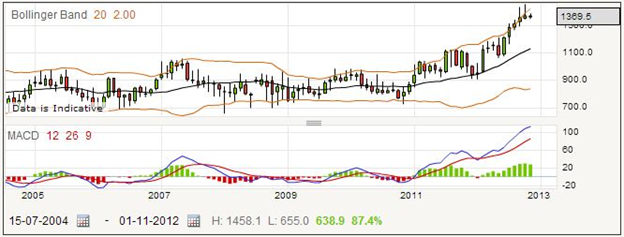Provident Financial is a financial group based in West Yorkshire. Over recent years, its lending practices have come under scrutiny, as detailed below, and you may find spread betting opportunities from any of these news items. Here is the monthly price chart, which shows relatively uninspiring performance in the company over the years, followed by a recent spurt.
The group was set up in 1880 with the intention of providing affordable credit to working families, with representatives going from house to house. While this idea was popular for the working classes, there have always been critics of the particular costs associated with this method of credit delivery, known as “home collected credit”.
Nonetheless, the company continued to provide a valued service, and became public in 1962 when it was listed on the London Exchange. It expanded towards the end of the 20th century, setting up operations in the Czech Republic, Poland, and later Hungary, Romania, Slovakia, and Mexico.
As part of its marketing push, in 2002 it formed Vanquis Bank Limited which as a licensed bank could issue credit cards. It specialized in issuing prepaid credit cards for members of the public who would find it difficult qualifying for a regular card.
In 2004 it ran into trouble, along with the few other major companies that provide credit at home, as this was seen as a lack of competitiveness. As a result of this, the companies were forced to set up a website that compared costs, and provide regular statements to their customers. While there were reservations, this was seen as a better option than the alternative of the public being forced to use unlicensed loan sharks.

In October 2012, Panorama ran a special program criticizing Provident Financial, but this does not seem to have had a major effect on the business. You can see from the chart above that volatility is low, so for spread trading this should be a relatively safe stock, and you should look for news items that may have some effect.
Provident Financial Rolling Daily: How to Spread Bet on Provident Financial shares?
The current spread betting quote for a rolling daily bet on Provident Financial is 1362.6 – 1371.4. As an example, if you think that the share price will go up you could place a long bet at 1371.4, staking perhaps £2.50 per point. As a long bet, you may find a small charge to your account each night when the bet is rolled over, but if your bet lasts no more than a few weeks and works out to be a winner, you should find that the profits are far greater than the charges.
For the example, assume that your bet is successful, with the price going up to 1453.2 – 1462.0. When you close your bet, it will be at the selling price of 1453.2. As the starting price was 1371.4, this means that you have gained 81.8 points. With a wager of £2.50 per point, that amounts to a profit of £204.50.
You must also consider that your bet may not win, and know how to work out your losses. Perhaps the price might fall after you place the bet, and you would close the trade when the price went down to 1303.7 – 1312.5. This time the bet closes at 1303.7. 1371.4-1303.7 is 67.7 points. Multiplying by £2.50, your loss works out to £169.25.
If you do not have time to watch the market every minute of the trading day, you should look into using a stop loss order on your spread bets. This requires your spread betting provider to close any of your bets that are losing once they reach a certain level that you set in advance. In this case, a stoploss order might have closed your bet when the price fell to 1319.2 – 1328.0. Your loss this time would be 1371.4 less 1319.2, or 52.2 points, and that would cost you £130.50 for your size of stake.
Provident Financial Futures Style Bet
Taking a medium-term trading view on Provident Financial, you might want to consider a quarterly futures type bet. These bets do not have any rollover adjustments, but a set expiry date some months in the future. You can of course close the bet at any time. The current price for the far quarter bet is 1368.4 – 1382.4.
Say that you are pessimistic about this stock, you might want to place a short or sell bet on the shares, staking £3.75 per point. The bet would go on at the selling price of 1368.4. Should the price drop to say 1256.9 – 1269.5, you could then close your trade and collect your profits. The closing price would be 1269.5, the higher of the quoted prices, because this was a short bet. Taking 1269.5 away from 1368.4, you find that you have won 98.9 points. Multiplying by £3.75, this amounts to winnings of £370.87.
If on the other hand the share price rises, you might be faced with the difficult decision to close your bet for a loss. This is often preferable to hanging on in hope that the price will turn around. Say the price went up to 1442.3 – 1455.0. This time the difference in points, 1455.0 minus 1368.4, which is 86.6 points, counts against you. £3.75 times 86.6 is a loss of £324.75.
Many spread traders use the stoploss order to keep an eye on their open bets, as this will help stop losses becoming too large. If you had placed a stop loss order on this bet when you opened it, you might find that the bet would be closed for you by your spread betting provider when the price went up to 1423.6 – 1435.2. With a starting price of 1368.4 and a closing price of 1435.2, you would have lost 66.8 points for a cost of £250.50.